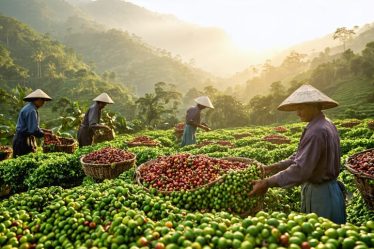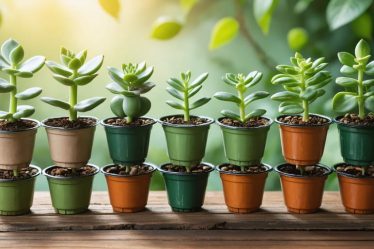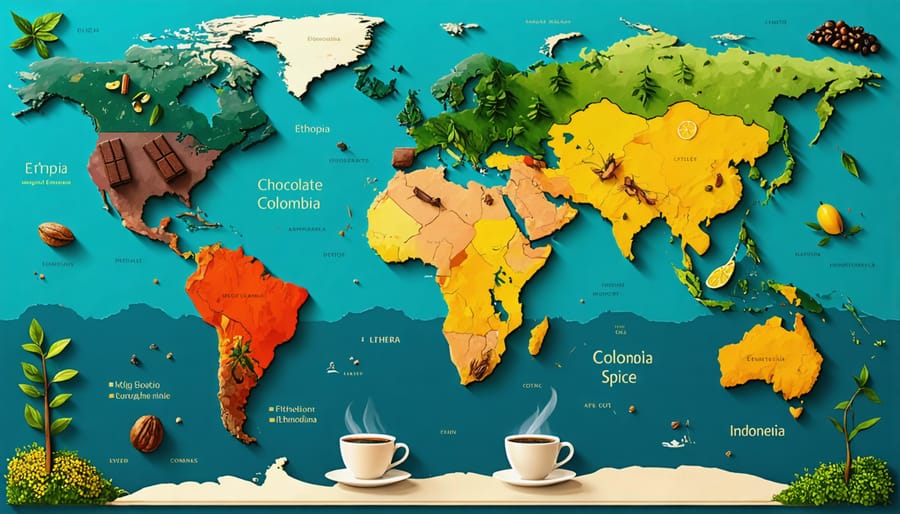
Embark on a sensory journey through the world’s most beloved coffee regions, where each bean tells a story through its unique flavor profile. From the bright, citrusy notes of Ethiopian Yirgacheffe to the rich, chocolate undertones of Colombian beans, understanding these distinct characteristics helps you preserve your coffee’s distinct flavors and craft your perfect cup.
Like wine enthusiasts who cherish regional differences, coffee lovers know that geography shapes taste. Altitude, soil composition, and climate work together to create flavor signatures as diverse as the landscapes where these beans grow. Whether you’re craving the caramel sweetness of Brazilian Santos or the spicy complexity of Sumatran beans, your morning brew connects you to these far-flung coffee paradises.
Join us as we explore how location influences your daily cup, helping you discover new favorites and understand why certain origins consistently capture your heart (and taste buds).
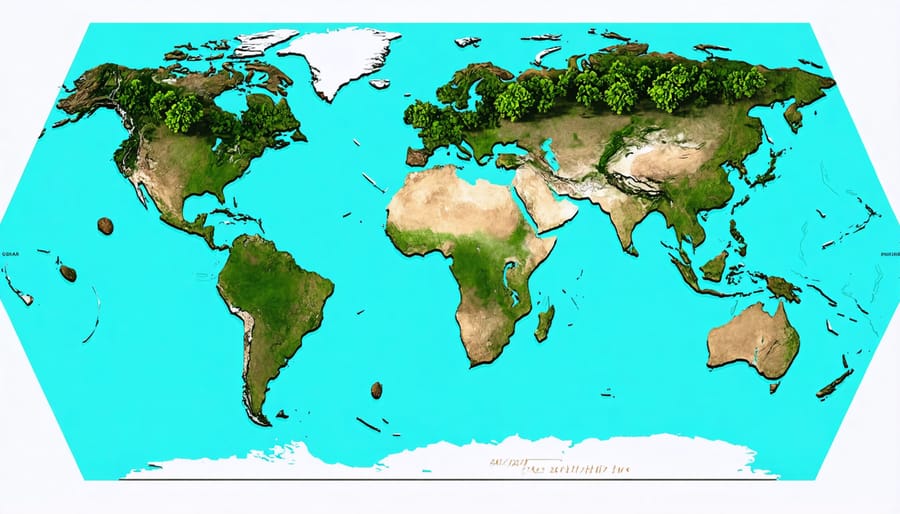
Latin American Coffee Profiles: Crowd-Pleasing Balance
Colombian Sweet Spot
When I think of Colombian coffee, I’m instantly transported to cozy Sunday mornings with a perfectly balanced cup that feels like a warm hug. Colombian beans are celebrated for their gentle caramel sweetness that doesn’t overwhelm but rather complements their medium body perfectly. Think of biting into a chocolate-covered caramel – that’s the kind of harmonious flavor experience you can expect.
What makes Colombian coffee truly special is its remarkable consistency and crowd-pleasing profile. The beans typically offer subtle notes of toasted nuts, a honey-like sweetness, and just enough brightness to keep things interesting. It’s this beautiful balance that makes Colombian coffee a fantastic “everyday” choice, whether you’re new to specialty coffee or a seasoned enthusiast.
If you’re looking for a foolproof coffee that’ll please everyone at your next brunch gathering, Colombian beans are your best friend. They’re versatile enough to work well with any brewing method, from your trusty drip machine to that fancy pour-over setup you’ve been perfecting.
Brazilian Bold
Picture wrapping your hands around a warm mug filled with Brazilian coffee – it’s like getting a comforting hug from your favorite sweater. Known as the world’s largest coffee producer, Brazil delivers beans that are wonderfully familiar and deeply satisfying. The country’s coffees typically greet you with delightful chocolate notes, reminiscent of your favorite dark chocolate bar, accompanied by toasted nuts and caramel undertones.
What makes Brazilian coffee truly special is its full-bodied nature and smooth, creamy texture. It’s the kind of coffee that feels substantial without being overwhelming – perfect for those mornings when you need a reliable companion to start your day. I especially love how these beans create a cup that’s both comforting and complex, with just enough brightness to keep things interesting.
Many of my readers tell me Brazilian coffee becomes their go-to choice for everyday drinking, and it’s easy to understand why. Its balanced profile makes it incredibly versatile, working beautifully in everything from your morning drip coffee to afternoon espresso.
Guatemala’s Complex Character
Every sip of Guatemalan coffee tells a fascinating story of its diverse growing regions. Like a perfectly orchestrated symphony, these beans deliver layers of flavor that dance on your palate – from bright citrus notes to deep chocolate undertones. What makes Guatemala’s coffee truly special is its distinctive spicy kick, often reminiscent of cinnamon or cardamom, that adds an exciting dimension to your morning cup.
The country’s volcanic soil and varied microclimates create beans with a full body and wonderfully complex character. You might notice hints of caramel sweetness balanced with a subtle smokiness, while some varieties offer delightful floral notes. It’s like having a cozy chat with an old friend – familiar and comforting, yet always revealing something new to discover.
Whether you’re new to specialty coffee or a seasoned enthusiast, Guatemalan beans offer an accessible yet sophisticated flavor profile that’s sure to enhance your daily coffee ritual.
African Coffee Stories: Bold and Bright
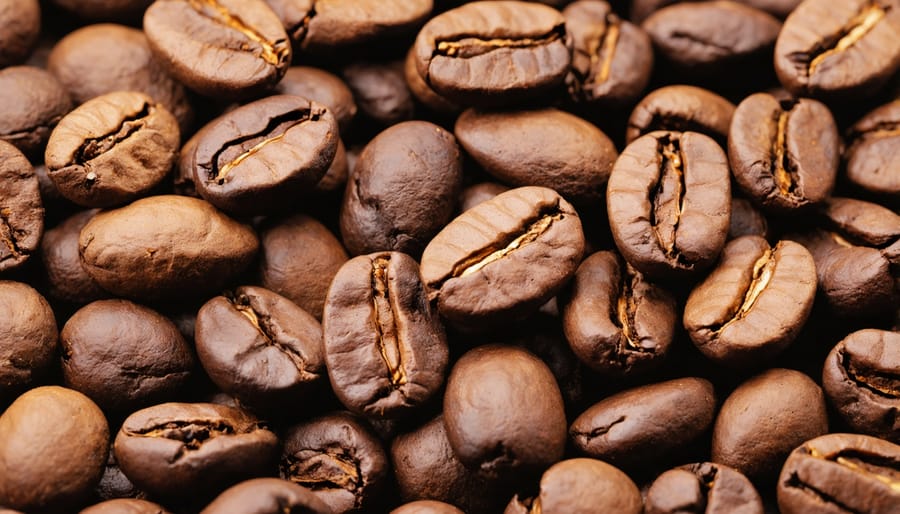
Ethiopian Elegance
Picture yourself walking through a sunlit garden filled with jasmine and bergamot – that’s the essence of Ethiopian coffee in your cup! As the birthplace of coffee, Ethiopia gifts us with some of the most distinctive and delightful flavor profiles you’ll ever experience.
Ethiopian beans are famous for their bright, tea-like qualities and complex floral notes that dance on your tongue. I’ll never forget my first sip of Ethiopian Yirgacheffe – it was like tasting sunshine! You’ll discover delicate hints of jasmine, complemented by citrus notes and sweet berry undertones that make each cup feel like a special occasion.
What makes these beans so unique? It’s all about location, darling! Growing at high altitudes in rich, volcanic soil, Ethiopian coffee develops those gorgeous floral characteristics naturally. The traditional processing methods used by local farmers also help preserve these delicate flavors.
If you’re new to Ethiopian coffee, start with a light to medium roast to fully appreciate its natural elegance. It’s perfect for your morning brew or as a refreshing afternoon pick-me-up, especially when you’re craving something bright and uplifting.
Kenyan Wine-Like Wonder
Picture savoring a glass of fine wine, but instead, you’re holding a cup of exceptional Kenyan coffee. That’s the magic these beans bring to your morning ritual! Grown in the rich, red volcanic soils of Kenya’s highlands, these coffees are celebrated for their bright, wine-like acidity that dances on your tongue.
What makes Kenyan coffee truly special is its distinctive berry notes – think blackcurrants fresh from the garden, sweet blackberries, and sometimes even a hint of tart cranberry. There’s often a delightful sweetness that reminds me of brown sugar or honey, perfectly balanced with that signature bright acidity.
I fell in love with Kenyan coffee during a tasting session where the host compared it to a crisp Pinot Noir, and honestly? The comparison couldn’t be more perfect. If you enjoy wines with vibrant fruit notes, you’ll likely adore Kenyan coffee’s complex flavor profile. It’s particularly delightful when served as a morning brew or an afternoon pour-over, where its clean, fruity characteristics can truly shine.
For the best experience, try it black first – you’ll want to fully appreciate those sophisticated berry notes that make Kenyan coffee so uniquely wonderful.
Asian-Pacific Gems: Earthy and Exotic
Indonesian Deep Earth
Picture yourself in a lush Indonesian rainforest, where the misty morning air carries hints of earth and spice. That’s exactly what you’ll experience in your cup with Indonesian coffee. These beans are famous for their deep, full-bodied character that feels like a warm, comforting hug on a chilly morning.
Indonesian coffees typically bring forward rich, complex flavors that remind me of fresh soil after rain, with subtle notes of dark chocolate and warm spices. What makes these beans truly special is their smooth, syrupy body and long-lasting finish that coffee lovers often describe as pleasantly lingering.
The volcanic soils of Indonesia, particularly in regions like Sumatra and Java, contribute to these distinctive characteristics. You’ll often notice subtle tobacco-like undertones and a gentle sweetness that balances the earthy qualities perfectly. If you’re someone who enjoys red wine or dark chocolate, you’ll likely appreciate Indonesian coffee’s bold personality.
These beans make an exceptional choice for cold brew or French press brewing, where their full-bodied nature really shines through. They’re also perfect for those mornings when you want something more substantial than a light, fruity coffee.
Vietnamese Bold Beauty
When I think of Vietnamese coffee, I’m instantly transported to bustling street cafes where the rich aroma of dark-roasted beans mingles with the morning air. Vietnamese coffee stands out for its bold, intense character – a testament to the country’s unique growing conditions and processing methods.
Typically made from Robusta beans grown in the Central Highlands, Vietnamese coffee delivers a powerful punch with deep chocolate notes and a delightful nutty finish. The signature strength comes from both the beans themselves (Robusta naturally contains more caffeine than Arabica) and the traditional dark roasting process that brings out a deliciously smoky quality.
What makes Vietnamese coffee truly special is its incredible versatility. Whether served hot or poured over ice, often with sweetened condensed milk to create the beloved cà phê sữa đá, these beans maintain their distinct personality. You’ll discover hints of caramel, dark chocolate, and sometimes even subtle tobacco notes that create a complex, full-bodied experience.
For those who love their coffee strong and assertive, Vietnamese beans offer an authentically bold choice that’s perfect for starting your day or creating indulgent coffee-based drinks.
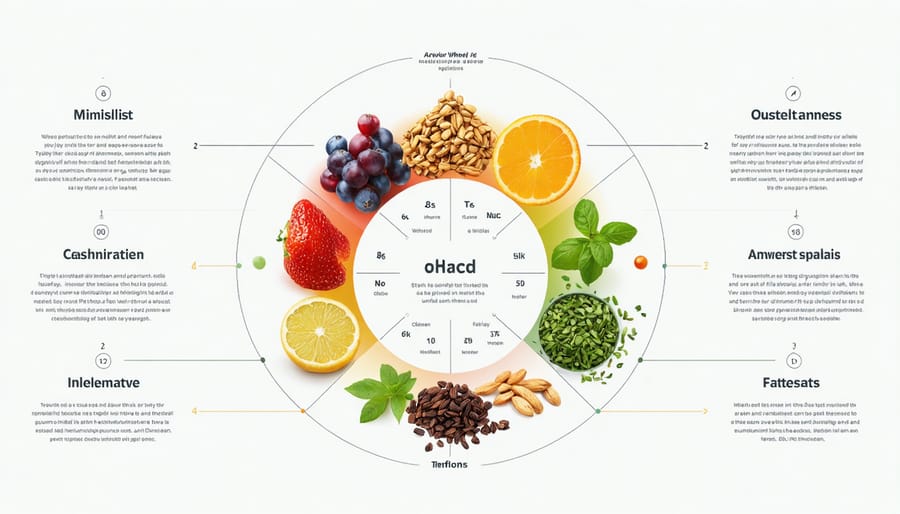
Pairing Your Coffee Profile
Finding your perfect coffee match is like discovering a new best friend – it’s all about understanding what makes you click! If you’re someone who enjoys bright, fruity flavors in your morning cup, Ethiopian or Kenyan coffees might become your new favorites. On the other hand, if you prefer something more mellow and chocolatey, Brazilian or Colombian beans could be your perfect match.
Consider how you typically start your day. Are you a black coffee purist, or do you enjoy adding cream and sugar? Light roasts from Central America tend to shine beautifully in pour-over brewing methods, while darker Indonesian roasts stand up wonderfully to milk-based drinks.
Don’t be afraid to experiment! Start with small quantities of different origins and keep notes about what you enjoy. Remember that even properly stored coffee beans are best enjoyed within a month of roasting, so buying smaller amounts ensures you’re always experiencing the best flavors.
Here’s a quick matching guide to get you started:
– If you enjoy wine and tea: Try Ethiopian or Kenyan coffees
– If you love chocolate and nuts: Go for Brazilian or Colombian beans
– If you’re into bold, earthy flavors: Explore Indonesian options
– If you prefer gentle, balanced taste: Consider Costa Rican or Guatemalan varieties
Remember, there’s no wrong choice – it’s all about what brings you joy in your cup! Start with these suggestions, but don’t hesitate to venture beyond them. Your perfect coffee match might surprise you, and the journey of discovery is half the fun.
As we’ve journeyed through the world of coffee origins, it’s clear that each region offers its own unique story in every cup. From the bright, citrusy notes of Ethiopian beans to the rich, chocolatey undertones of Colombian coffee, there’s truly something for every coffee lover to discover and enjoy.
Remember, these regional profiles are just starting points in your coffee adventure. Your personal taste preferences might lead you to fall in love with the caramel sweetness of Brazilian beans or the complex spiciness of Indonesian varieties. Don’t be afraid to experiment and try coffees from different origins – you might be surprised by what delights your palate!
I encourage you to start your own origin-tasting journey. Pick up beans from two or three different regions and brew them side by side. Notice the subtle differences, take notes, and most importantly, enjoy the process of discovering your perfect cup. Whether you’re a morning coffee ritualist or an afternoon sipper, understanding these regional differences will transform your daily coffee experience from a simple routine into a delightful exploration of flavors from around the world.


